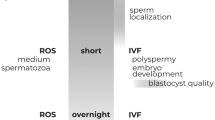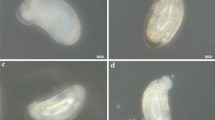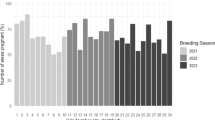Abstract
IN a recent communication in Nature by Moore, Woodroffe and Sanderson1, it was shown that the spider beetle Ptinus latro Fab. exists only as females and that these require to be inseminated by males of the allied Ptinus hirtellus Sturm in order to produce viable eggs. Insemination by sterilized males was ineffective. The details of the cytological phenomena involved were communicated at the Tenth International Congress of Entomology, 1956 2. Since no conclusions could be reached as to whether the sperm enters the yolk of the P. latro egg, it is proposed to carry out experiments using labelled sperm and autoradiography. Meanwhile, the following is a report on results of experiments on artificial activation of the virgin egg. The methods employed involved cold and heat treatments, exposure to ether vapour, and puncturing with a fine glass needle, but the best results were obtained with the needle puncture method or traumatization. It was found that the maturation division proceeded as far as telophase (Fig. 1) in 50–60 per cent of the 200 eggs treated. Eggs were squashed in aceto-orcein from 10 to 120 min. after puncture and it was observed that the maturation division is complete usually after 30 min. However, no onset of cleavage was seen up to 2 hr., after which time the eggs tend to dry up. In untreated eggs from virgin females, the development is usually blocked at the first metaphase (Fig. 2). The chromosomes may remain in this stage up to a period of five days, and then degenerate. From the remarkably high percentage of eggs activated by traumatization, it seems reasonable to assume that the role of the sperm in initiating activation is mainly of a physical nature. Further work is in progress and will be reported elsewhere.
This is a preview of subscription content, access via your institution
Access options
Subscribe to this journal
Receive 51 print issues and online access
$199.00 per year
only $3.90 per issue
Buy this article
- Purchase on SpringerLink
- Instant access to full article PDF
Prices may be subject to local taxes which are calculated during checkout
Similar content being viewed by others
References
Moore, B. P., Woodroffe, G. E., and Sanderson, Ann R., Nature, 177, 847 (1956).
Sanderson, Ann R., Proc. Tenth Int. Cong. Ent. (1956) (in the press).
Author information
Authors and Affiliations
Rights and permissions
About this article
Cite this article
SANDERSON, A., JACOB, J. Artificial Activation of the Egg in a Gynogenetic Spider Beetle. Nature 179, 1300 (1957). https://doi.org/10.1038/1791300a0
Issue date:
DOI: https://doi.org/10.1038/1791300a0



